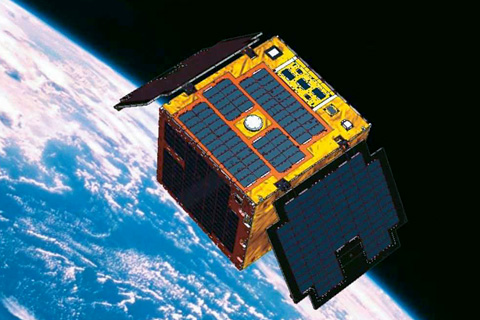DIWATA-2 Launches
29 October 2018

The Philippines will launch today the DIWATA-2 microsatellite (Small Demonstration Satellite-2), marking the country’s third venture into space under the P840-million PHL-MICROSAT Program of the Department of Science and Technology (DOST).
The microsatellite that will orbit the Earth every 90 minutes and pass over the Philippines up to four times per day is carried as a secondary payload of the H-IIA F40 rocket and will be launched from the Tanegashima Space Center, Japan between 12:08 p.m. and 12:20 p.m. today, Philippine Time.
This is the second experimental microsatellite developed by the University of the Philippines (UP) in collaboration with Hokkaido University and Tohoku University of Japan. The DIWATA-2 continues the heritage of DIWATA-1, the country’s first microsatellite deployed on April 27, 2016 from the International Space Station (ISS).
Under the PHL-MICROSAT Program, the two microsatellites are initially designed to capture images of the Philippines for environmental monitoring, disaster response and management.
Due to technical and operational issues plaguing the DIWATA-1 program, it has failed to fully deliver on its promise of using space technology for public service. The DIWATA-1 has covered only around 32 percent of the land area of the Philippines since 2016. It is unlikely to be able to cover the rest of the country with its remaining orbital lifetime of less than two years.
DIWATA-2 will have a lifespan of five years as compared to DIWATA-1 which will orbit at a higher altitude of 620 kilometers for an increased lifespan and a sun-synchronous orbit, which will enable fixed revisit intervals that would make repeated environmental monitoring of specific areas possible.
Both microsatellites carry the High Precision Telescope and the Spaceborne Multispectral Imager as payloads. It will also carry a Wide Field Camera (WFC), Middle Field Camera (MFC), High Precision Telescope (HPT) and Spaceborne Multispectral Imager (SMI) with Liquid Crystal Tunable Filter (LCTF).
Diwata-2 will have deployable solar panels as compared to DIWATA-1 for increased power generation output and an Enhanced Resolution Camera (ERC), for increasing the resolution of images taken by SMI. Furthermore, it will feature two locally made experimental modules: An Amateur Radio Unit for emergency communications and a Satellite Orientation Module for increased pointing accuracy and future satellite development initiatives.
The satellite was monitored by the DOST-Philippine Council for Industry and Emerging Technology Research and Development (PCIEERD), and done through the collaboration between the University of the Philippines Diliman, the DOST-Advanced Science and Technology Institute (ASTI), Hokkaido University and Tohoku University.
The DIWATA-2 will be launched together with six other satellites, including GOSAT-2 of Japan and Khalifasat of the United Arab Emirates as the primary payloads.
Both Diwata-1 and Diwata-2 are Earth-observing microsatellites capable of capturing images of Earth for environmental assessment. The satellite control, operation, and acquisition of experimental data will be done at the Philippine Earth Data Resource Observation Center (PEDRO), which is housed by DOST-ASTI.
29 October 2018

The Philippines will launch today the DIWATA-2 microsatellite (Small Demonstration Satellite-2), marking the country’s third venture into space under the P840-million PHL-MICROSAT Program of the Department of Science and Technology (DOST).
The microsatellite that will orbit the Earth every 90 minutes and pass over the Philippines up to four times per day is carried as a secondary payload of the H-IIA F40 rocket and will be launched from the Tanegashima Space Center, Japan between 12:08 p.m. and 12:20 p.m. today, Philippine Time.
This is the second experimental microsatellite developed by the University of the Philippines (UP) in collaboration with Hokkaido University and Tohoku University of Japan. The DIWATA-2 continues the heritage of DIWATA-1, the country’s first microsatellite deployed on April 27, 2016 from the International Space Station (ISS).
Under the PHL-MICROSAT Program, the two microsatellites are initially designed to capture images of the Philippines for environmental monitoring, disaster response and management.
Due to technical and operational issues plaguing the DIWATA-1 program, it has failed to fully deliver on its promise of using space technology for public service. The DIWATA-1 has covered only around 32 percent of the land area of the Philippines since 2016. It is unlikely to be able to cover the rest of the country with its remaining orbital lifetime of less than two years.
DIWATA-2 will have a lifespan of five years as compared to DIWATA-1 which will orbit at a higher altitude of 620 kilometers for an increased lifespan and a sun-synchronous orbit, which will enable fixed revisit intervals that would make repeated environmental monitoring of specific areas possible.
Both microsatellites carry the High Precision Telescope and the Spaceborne Multispectral Imager as payloads. It will also carry a Wide Field Camera (WFC), Middle Field Camera (MFC), High Precision Telescope (HPT) and Spaceborne Multispectral Imager (SMI) with Liquid Crystal Tunable Filter (LCTF).
Diwata-2 will have deployable solar panels as compared to DIWATA-1 for increased power generation output and an Enhanced Resolution Camera (ERC), for increasing the resolution of images taken by SMI. Furthermore, it will feature two locally made experimental modules: An Amateur Radio Unit for emergency communications and a Satellite Orientation Module for increased pointing accuracy and future satellite development initiatives.
The satellite was monitored by the DOST-Philippine Council for Industry and Emerging Technology Research and Development (PCIEERD), and done through the collaboration between the University of the Philippines Diliman, the DOST-Advanced Science and Technology Institute (ASTI), Hokkaido University and Tohoku University.
The DIWATA-2 will be launched together with six other satellites, including GOSAT-2 of Japan and Khalifasat of the United Arab Emirates as the primary payloads.
Both Diwata-1 and Diwata-2 are Earth-observing microsatellites capable of capturing images of Earth for environmental assessment. The satellite control, operation, and acquisition of experimental data will be done at the Philippine Earth Data Resource Observation Center (PEDRO), which is housed by DOST-ASTI.
No comments:
Post a Comment